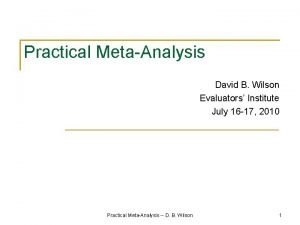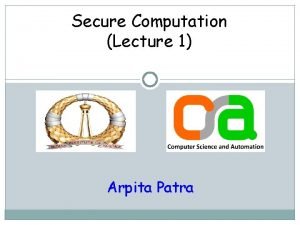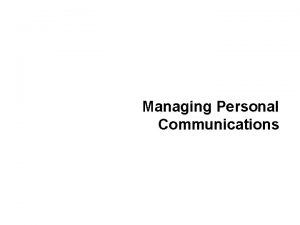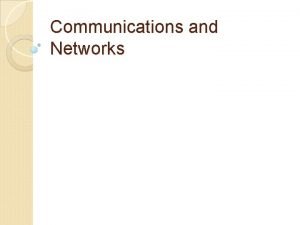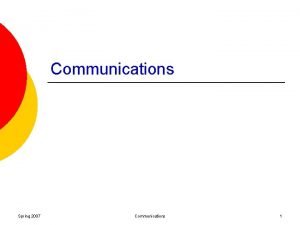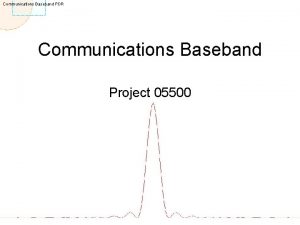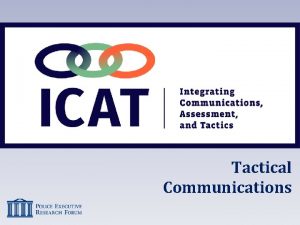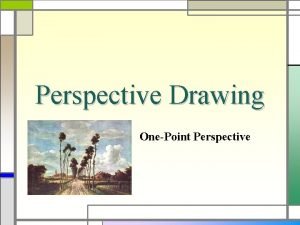A Communications Perspective for Evaluators Shareefa Choudhury 23













- Slides: 13

A Communications Perspective for Evaluators Shareefa Choudhury 23 rd June 2011 Slide 1

Introduction • Overview of DFID • Our approach to communications • Use of online and social media tools • Communications planning for Evaluators Slide 2

DFID Overview • Recent review of all aid programmes • Re-focussing of aid in: – Fewer countries (27 instead of 43 bilateral programmes) – Targeted where biggest difference will be made – results focus – And where the need is greatest • Communications drive is about reporting back on results delivered on the promises made in the aid review • Increased focus on transparency Slide 3

DFID’s approach to Comms • Focus on mainstream interested UK audiences – audience segmentation based on attitudes and support for development • Tell stories of results using beneficiary voices • Particular aim at growing online and social media audiences Slide 4

Messaging and Content • Tone: Positive, honest, personal, factual, empowering, emotional and energised • Style: The stories are told by the beneficiary • Story: A named individual – UK aid is changing the life of this person - it is cheap / good value, innovative and / or effective. – Skills or tools gained – Wider transformation in country/region – Delivering on the global promise Slide 5

Mock up page Slide 6

Slide 7

Planning Communications for Evaluations Key points to think about in planning stages: • Objectives • Audiences • Messages • Channels • Milestones • Partners • Risks • Evaluation Slide 8

Objectives What do you want to achieve by communicating? • Share the findings, information, data? • Influence the debate? • Call to action? • Raise awareness? Slide 9

Audiences and Messages • Audiences: Who are you trying to reach? Do you know enough about what they are interested in, what will resonate with them, how best to reach them? • Key messages: What do you want to say? What are your top lines (jargon free)? Think about what you want to achieve by communicating? This will influence your messaging Slide 10

Channels and Milestones Channels: How will you get your messages out? What means will you use? Select channels to suit the audience. i. e there is no point putting things online if you’re audience don’t access the internet. • Milestones: What are the key milestones that are relevant to your comms activities? What hooks can you use to make your message more current and relevant? Slide 11

Partners and Risks • Partners: Who do you need to work with? Is there a joint message? Can they give you information you need? • Risks: What are the key risks you face in communicating your messages? What if your findings are not good – how will you deal with criticism? Slide 12

Evaluation of Communications Measure the impact of your comms – you know this best! Slide 13
 Washington evaluators
Washington evaluators Evaluators institute
Evaluators institute Nina roy choudhury
Nina roy choudhury Bepin choudhury's lapse of memory ppt
Bepin choudhury's lapse of memory ppt Romit roy choudhury
Romit roy choudhury Arpita patra iisc
Arpita patra iisc Rbar
Rbar Romit roy choudhury
Romit roy choudhury Jahanara choudhury
Jahanara choudhury Fayezul choudhury
Fayezul choudhury Silo perspective vs business process perspective
Silo perspective vs business process perspective How to draw stairs in 2 point perspective
How to draw stairs in 2 point perspective Nationell inriktning för artificiell intelligens
Nationell inriktning för artificiell intelligens Bästa kameran för astrofoto
Bästa kameran för astrofoto

